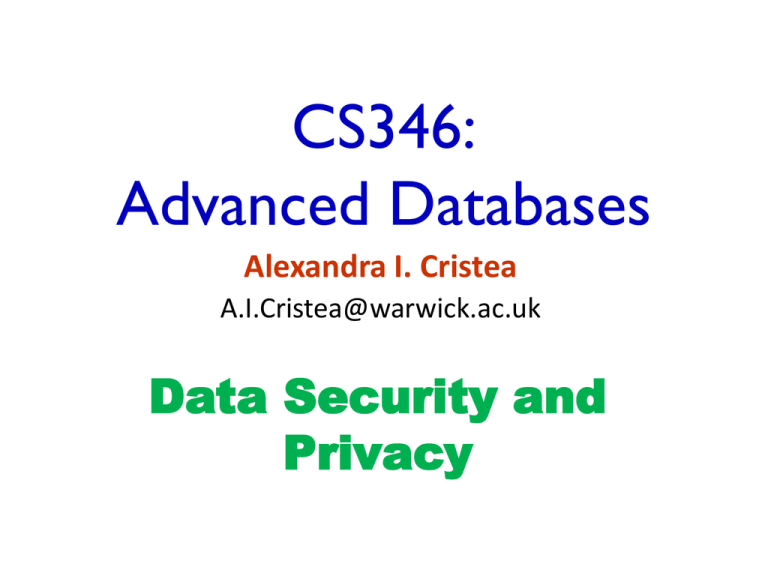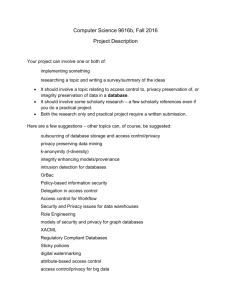
CS346:
Advanced Databases
Alexandra I. Cristea
A.I.Cristea@warwick.ac.uk
Data Security and
Privacy
Outline
Chapter: “Database Security” in Elmasri and Navathe
(chapter 24, 6th Edition)
Brief overview of database security
More detailed study of database privacy
Statistical databases, and differential privacy to protect data
– Data anonymization: k-anonymity and l-diversity
–
Why?
A topical issue: privacy and security are big concerns
Connections to computer security, statistics
2
CS346 Advanced Databases
Database Security and Privacy
Database Security and Privacy is a large and complex area, covering:
Legal and ethical requirements for data privacy
E.g. UK Data Protection Act (1998)
– Determines for how long data can be retained about people
–
Government and organisation policy issues on data sharing
–
E.g. when and how credit reports, medical data can be shared
System-level issues for security management
–
How is access to data controlled by the system?
Classification of data by security levels (secret, unclassified)
–
3
How to determine if access to data is permitted?
CS346 Advanced Databases
Threats to Databases
Databases faces many threats which must be protected against
Integrity: prevent improper modification of the data
Caused by intention or accident, insider or outsider threat
– Erroneous data can lead to incorrect decisions, fraud, errors
–
Availability: is the data available to users and programs?
–
Denial of service attacks prevent access, cost revenue/reputation
Confidentiality: protect data from unauthorized disclosure
–
Leakage of information could violate law, customer confidence
Sometimes referred to as the CIA triad
4
CS346 Advanced Databases
Control measures
Security is provided by control measures of various types
Access control: affect who can access the data / the system
–
Different users may have different levels of access
Inference control: control what data implies about individuals
–
Try to make it impossible to infer facts about individuals
Flow control: prevent information from escaping the database
E.g. can data be transferred to other applications?
– Control covert channels that can be used to leak data
–
Data Encryption: store encrypted data in the database
At the field level or at the whole file level
– Trade-off between security and ease of processing
–
5
CS346 Advanced Databases
Information Security and Information Privacy
The dividing line between security and privacy is hard to draw
Security: prevent unauthorised use of system and data
E.g. access controls to lock out unauthorised users
– E.g. encryption to hide data from those without the key
–
Privacy: control the use of data
Ensure that private information does not emerge from queries
– Ability of individuals to control the use of their data
–
Will focus on database privacy for the remainder
6
CS346 Advanced Databases
Statistical Databases and Privacy
Statistical databases keep data on large groups
–
E.g. national population data (Office of National Statistics)
The raw data in statistical databases is confidential
–
Detailed data about individuals e.g. from census
Users are permitted to retrieve statistics from the data
–
E.g. averages, sums, counts, maximum values etc.
Providing security for statistical databases is a big challenge
Many crafty ways to extract private information from them
– The database should prevent queries that leak information
–
7
CS346 Advanced Databases
Statistical Database challenges
Very specific queries can refer to a single person
E.g. SELECT AVG(Salary) FROM EMPLOYEE WHERE AGE=22 AND
POSTCODE=‘W1A 1AA’ AND DNO=5 : 45,000
– SELECT COUNT(*) FROM EMPLOYEE WHERE AGE=22 AND
POSTCODE=‘W1A 1AA’ AND DNO=5 AND SALARY>40000 : 1
–
How would you detect and reject such queries?
Can arrange queries where the difference is small
SELECT COUNT(*) FROM EMPLOYEE WHERE AGE>=22 AND
DNO=5 AND SALARY>40000 : 12
– SELECT COUNT(*) FROM EMPLOYEE WHERE AGE>=23 AND
DNO=5 AND SALARY>40000 : 11
–
8
CS346 Advanced Databases
Differential Privacy for Statistical Databases
Principle: query answers reveals little about any individual
–
Even if adversary knows (almost) everything about everyone else!
Thus, individuals should be secure about contributing their data
–
What is learnt about them is about the same either way
Much work on providing differential privacy (DP)
Simple recipe for some data types (e.g. numeric answers)
– Simple rules allow us to reason about composition of results
– More complex algorithms for arbitrary data
–
Adopted and used by several organizations:
–
9
US Census, Common Data Project, Facebook (?)
Differential Privacy Definition
The output distribution of a differentially private algorithm
changes very little whether or not any individual’s data is
included in the input
– so you should contribute your data
10
Laplace Mechanism
The Laplace Mechanism adds random noise to query results
–
Scaled to mask the contribution of any individual
Add noise from a symmetric continuous distribution to true answer
– Laplace distribution is a symmetric exponential distribution
– Laplace provides DP for COUNT queries, as shifting the distribution
changes the probability by at most a constant factor
–
11
CS346 Advanced Databases
Sensitivity of Numeric Functions
For more complex functions, we need to calibrate the noise
to the influence an individual can have on the output
The (global) sensitivity of a function F is the maximum
(absolute) change over all possible adjacent inputs
– S(F) = maxD, D’ : |D-D’|=1 |F(D) – F(D’)|
– Intuition: S(F) characterizes the scale of the influence of one
individual, and hence how much noise we must add
–
S(F) is small for many common functions
S(F) = 1 for COUNT
– S(F) = 2 for HISTOGRAM
Female Male
– Bounded for other functions (MEAN, covariance matrix…)
–
12
CS346 Advanced Databases
Data Anonymization
The idea of data anonymization is compelling, has many applications
For Data Sharing
Give real(istic) data to others to study without compromising privacy
of individuals in the data
– Allows third-parties to try new analysis and mining techniques not
thought of by the data owner
–
For Data Retention and Usage
Various requirements prevent companies from retaining customer
information indefinitely
– E.g. Google progressively anonymizes IP addresses in search logs
– Internal sharing across departments (e.g. billing marketing)
–
13
CS346 Advanced Databases
Case Study: US Census
Raw data: information about every US household
–
Who, where; age, gender, racial, income and educational data
Why released: determine representation, planning
How anonymized: aggregated to geographic areas (Zip code)
Broken down by various combinations of dimensions
– Released in full after 72 years
–
Attacks: no reports of successful deanonymization
–
Recent attempts by FBI to access raw data rebuffed
Consequences: greater understanding of US population
Affects representation, funding of civil projects
– Rich source of data for future historians and genealogists
–
14
CS346 Advanced Databases
Case Study: Netflix Prize
Raw data: 100M dated ratings from 480K users to 18K movies
Why released: improve predicting ratings of unlabeled examples
How anonymized: exact details not described by Netflix
All direct customer information removed
– Only subset of full data; dates modified; some ratings deleted,
– Movie title and year published in full
–
Attacks: dataset is claimed vulnerable
Attack links data to IMDB where same users also rated movies
– Find matches based on similar ratings or dates in both
–
Consequences: rich source of user data for researchers
–
15
Unclear how serious the attacks are in practice
CS346 Advanced Databases
Case Study: AOL Search Data
Raw data: 20M search queries for 650K users from 2006
Why released: allow researchers to understand search patterns
How anonymized: user identifiers removed
–
All searches from same user linked by an arbitrary identifier
Attacks: many successful attacks identified individual users
Ego-surfers: people typed in their own names
– Zip codes and town names identify an area
– NY Times identified user 4417749 as 62yr old widow
–
Consequences: CTO resigned, two researchers fired
–
16
Well-intentioned effort failed due to inadequate anonymization
CS346 Advanced Databases
Last time:
–
generalities about security, privacy; case studies privacy
Next:
–
17
Anonymisation, de-identification, attacks
CS346 Advanced Databases
Models of Anonymization
Interactive Model (akin to statistical databases)
Data owner acts as “gatekeeper” to data
– Researchers pose queries in some agreed language
– Gatekeeper gives an (anonymized) answer, or refuses to answer
–
“Send me your code” model
Data owner executes code on their system and reports result
– Cannot be sure that the code is not malicious
–
Offline, aka “publish and be damned” model
Data owner somehow anonymizes data set
– Publishes the results to the world, and retires
– The model used in most real data releases
–
18
CS346 Advanced Databases
Objectives for Anonymization
Prevent (high confidence) inference of associations
Prevent inference of salary for an individual in “census”
– Prevent inference of individual’s viewing history in “video”
– Prevent inference of individual’s search history in “search”
– All aim to prevent linking sensitive information to an individual
–
Prevent inference of presence of an individual in the data set
Satisfying “presence” also satisfies “association” (not vice-versa)
– Presence in a data set can violate privacy (e.g., STD clinic patients)
–
Have to consider what knowledge might be known to attacker
Background knowledge: facts about the data set (X has salary Y)
– Domain knowledge: broad properties of data (illness Z rare in men)
–
19
CS346 Advanced Databases
Utility
Anonymization is meaningless if utility of data not considered
The empty data set has perfect privacy, but no utility
– The original data has full utility, but no privacy
–
What is “utility”? Depends what the application is…
For fixed query set, can look at maximum or average error
– Problem for publishing: want to support unknown applications!
– Need some way to quantify utility of alternate anonymizations
–
20
CS346 Advanced Databases
Definitions of Technical Terms
Identifiers–uniquely identify, e.g. Social Security Number (SSN)
Step 0: remove all identifiers
– Was not enough for AOL search data
–
Quasi-Identifiers (QI)—such as DOB, Sex, ZIP Code
Enough to partially identify an individual in a dataset
– DOB+Sex+ZIP unique for 87% of US Residents [Sweeney 02]
–
Sensitive attributes (SA)—the associations we want to hide
Salary in the “census” example is considered sensitive
– Not always well-defined: only some “search” queries sensitive
– In “video”, association between user and video is sensitive
– One SA can reveal others: bonus may identify salary…
–
21
CS346 Advanced Databases
Tabular Data Example
Census data recording incomes and demographics
SSN
11-1-111
22-2-222
33-3-333
44-4-444
55-5-555
66-6-666
DOB
1/21/76
4/13/86
2/28/76
1/21/76
4/13/86
2/28/76
Sex
M
F
M
M
F
F
ZIP
53715
53715
53703
53703
53706
53706
Salary
50,000
55,000
60,000
65,000
70,000
75,000
Releasing SSN Salary association violates individual’s privacy
–
22
SSN is an identifier, Salary is a sensitive attribute (SA)
CS346 Advanced Databases
Tabular Data Example: De-Identification
Census data: remove SSN to create de-identified table
–
Remove an attribute from the data
DOB
1/21/76
4/13/86
2/28/76
1/21/76
4/13/86
2/28/76
Sex
M
F
M
M
F
F
ZIP
53715
53715
53703
53703
53706
53706
Salary
50,000
55,000
60,000
65,000
70,000
75,000
Does the de-identified table preserve an individual’s privacy?
–
23
Depends on what other information an attacker knows
CS346 Advanced Databases
Tabular Data Example: Linking Attack
De-identified private data + publicly available data
DOB
Sex
ZIP
Salary
1/21/76 M 53715 50,000
4/13/86 F 53715 55,000
2/28/76 M 53703 60,000
1/21/76 M 53703 65,000
4/13/86 F 53706 70,000
2/28/76 F 53706 75,000
SSN
11-1-111
33-3-333
Cannot uniquely identify either individual’s salary
–
24
DOB is a quasi-identifier (QI)
CS346 Advanced Databases
DOB
1/21/76
2/28/76
Tabular Data Example: Linking Attack
De-identified private data + publicly available data
DOB Sex ZIP Salary
1/21/76 M 53715 50,000
4/13/86 F 53715 55,000
2/28/76 M 53703 60,000
1/21/76 M 53703 65,000
4/13/86 F 53706 70,000
2/28/76 F 53706 75,000
SSN
DOB Sex
11-1-111 1/21/76 M
33-3-333 2/28/76
M
Uniquely identified one individual’s salary, but not the other’s
–
25
DOB, Sex are quasi-identifiers (QI)
CS346 Advanced Databases
Tabular Data Example: Linking Attack
De-identified private data + publicly available data
DOB
Sex
ZIP
Salary
1/21/76 M 53715 50,000
4/13/86 F 53715 55,000
2/28/76 M 53703 60,000
1/21/76 M 53703 65,000
4/13/86 F 53706 70,000
2/28/76 F 53706 75,000
SSN
DOB
Sex
ZIP
11-1-111 1/21/76 M 53715
33-3-333 2/28/76
M
Uniquely identified both individuals’ salaries
–
26
[DOB, Sex, ZIP] is unique for lots of US residents [Sweeney 02]
CS346 Advanced Databases
53703
Tabular Data Example: Anonymization
Anonymization through row suppression / deletion
DOB
Sex
*
*
4/13/86 F
2/28/76 M
*
*
4/13/86 F
2/28/76 F
ZIP
*
53715
53703
*
53706
53706
Salary
*
55,000
60,000
*
70,000
75,000
SSN
DOB
Sex
ZIP
11-1-111 1/21/76 M 53715
Cannot link to private table even with knowledge of QI values
Missing values could take any permitted value
– Looses a lot of information from the data
–
27
CS346 Advanced Databases
Tabular Data Example: Anonymization
Anonymization through QI attribute generalization
DOB Sex ZIP Salary
1/21/76 M 537** 50,000
4/13/86 F 537** 55,000
2/28/76 * 537** 60,000
1/21/76 M 537** 65,000
4/13/86 F 537** 70,000
2/28/76 * 537** 75,000
SSN
DOB
Sex
ZIP
11-1-111 1/21/76 M 53715
33-3-333 2/28/76 M 53703
Cannot uniquely identify row with knowledge of QI values
Fewer possibilities than row suppression
– E.g., ZIP = 537** → ZIP {53700, …, 53799}
–
28
CS346 Advanced Databases
k-Anonymization
k-anonymity: Table T satisfies k-anonymity with respect to quasiidentifier QI if and only if each tuple in (the multiset) T[QI]
appears at least k times
–
Protects against “linking attack”
k-anonymization: Table T’ is a k-anonymization of T if T’ is a
generalization/suppression of T, and T’ satisfies k-anonymity
DOB
1/21/76
4/13/86
2/28/76
1/21/76
4/13/86
2/28/76
Sex
M
F
M
M
F
F
ZIP
53715
53715
53703
53703
53706
53706
Salary
50,000
55,000
60,000
65,000
70,000
75,000
→
DOB
1/21/76
4/13/86
2/28/76
1/21/76
4/13/86
2/28/76
ZIP
537**
537**
537**
537**
537**
537**
T’
T
29
Sex
M
F
*
M
F
*
CS346 Advanced Databases
Salary
50,000
55,000
60,000
65,000
70,000
75,000
k-Anonymization and queries
Data Analysis
Analysis should (implicitly) range over all possible tables
– Example question: what is the salary of individual (1/21/76, M,
53715)? Best guess is 57,500 (average of 50,000 and 65,000)
– Example question: what is the maximum salary of males in 53706?
Could be as small as 50,000, or as big as 75,000
–
DOB
Sex
1/21/76 M
4/13/86 F
2/28/76 *
1/21/76 M
4/13/86 F
2/28/76 *
30
ZIP
537**
537**
537**
537**
537**
537**
CS346 Advanced Databases
Salary
50,000
55,000
60,000
65,000
70,000
75,000
Homogeneity Attack
Issue: k-anonymity requires each tuple in (the multiset) T[QI] to
appear ≥ k times, but does not say anything about the SA values
If (almost) all SA values in a QI group are equal, loss of privacy!
– The problem is with the choice of grouping, not the data
–
DOB
1/21/76
4/13/86
2/28/76
1/21/76
4/13/86
2/28/76
31
Sex
M
F
M
M
F
F
ZIP
53715
53715
53703
53703
53706
53706
Salary
50,000
55,000 Not Ok!
60,000
50,000
55,000
60,000
→
DOB
1/21/76
4/13/86
2/28/76
Sex ZIP Salary
* 537** 50,000
* 537** 55,000
* 537** 60,000
1/21/76 *
4/13/86 *
2/28/76 *
CS346 Advanced Databases
537** 50,000
537** 55,000
537** 60,000
Homogeneity Attack
Issue: k-anonymity requires each tuple in (the multiset) T[QI] to
appear ≥ k times, but does not say anything about the SA values
If (almost) all SA values in a QI group are equal, loss of privacy!
– The problem is with the choice of grouping, not the data
– For some groupings, no loss of privacy
–
DOB Sex ZIP Salary
1/21/76 M 53715 50,000
4/13/86 F 53715 55,000
2/28/76 M 53703 60,000
1/21/76 M 53703 50,000
4/13/86 F 53706 55,000
2/28/76 F 53706 60,000
32
→
Ok!
CS346 Advanced Databases
DOB Sex ZIP Salary
76-86 * 53715 50,000
76-86 * 53715 55,000
76-86 * 53703 60,000
76-86
76-86
76-86
*
*
*
53703 50,000
53706 55,000
53706 60,000
Homogeneity
Intuition: A k-anonymized table T’ represents the set of all
possible tables Ti s.t. T’ is a k-anonymization of Ti
Lack of diversity of SA values implies that for large fraction of
possible tables, some fact is true, which can violate privacy
DOB Sex ZIP Salary
1/21/76 * 537** 50,000
4/13/86 * 537** 55,000
2/28/76 * 537** 60,000
1/21/76 * 537** 50,000
4/13/86 * 537** 55,000
2/28/76 * 537** 60,000
33
SSN
DOB
Sex
ZIP
11-1-111 1/21/76 M 53715
CS346 Advanced Databases
l-Diversity
l-Diversity Principle: a table is l-diverse if each of its QI groups
contains at least l “well-represented” values for the SA
–
Frequency l-diversity: for each QI group g, no SA value should occur
more than 1/l fraction of the time
DOB
Sex
ZIP
Salary
1/21/76 * 537** 50,000
4/13/86 * 537** 50,000
2/28/76 * 537** 60,000
1/21/76
4/13/86
2/28/76
*
*
*
537** 55,000
537** 55,000
537** 65,000
Even l-diversity has its weaknesses: an adversary can use machine
learning techniques to make inferences about individuals
34
CS346 Advanced Databases
Summary
Concepts in database security: integrity, availability, confidentiality
Statistical databases, and differential privacy to protect data
Data anonymization: k-anonymity and l-diversity
Identifiers, Quasi-identifiers, sensitive attributes
Recommended reading:
Chapter: “Database Security” in Elmasri and Navathe
“A Firm Foundation for Private Data Analysis”, Cynthia Dwork
“k-anonymity”, V. Ciriani, S. De Capitani di Vimercati, S. Foresti, and
P. Samarati
35
CS346 Advanced Databases







